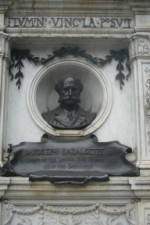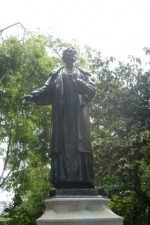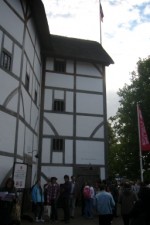Heroes
Posted On July 3, 2011
My recent trip to London became a pilgrimage. It wasn’t planned that way, but I found paying homage to some of my long-time heroes and inspirations, deliberately seeking out their works and their memorials and acknowledging their influence.

In no particular order:
- Charles Darwin. At West Minster Abbey, I sought out Darwin’s burial place and memorial. The Natural History Museum was almost like a shrine dedicated to the great man, especially with the spanking brand new gob-smacking Darwin Centre. Even the Kew Gardens had a special Darwin inspired ‘Evolution House’. I heard an academic once say that Darwin had ‘the single best idea of anyone, ever.’ Clear-thinking, rational, careful, painstaking, imaginative – Darwin has always been an inspiration.
- Joseph Bazalgette. Joseph who? Bazalgette was a Victorian era engineer, and he revolutionised London. He was the one who built the staggeringly complex system of sewers that turned London from a festering cesspit into a relatively clean city. He was responsible for other works, but it’s the sewers for which he’ll be remembered. Can I get excited about a sewer king? You bet. This project was
 mind-numbingly difficult, uprooting the major thoroughfares of an already busy city, coordinating hundreds of workers, using millions of bricks, building huge pumping works, all to take care of something that decent people didn’t really want to talk about. His memorial was hard to find – a relatively modest display on the Embankment. He deserves better. I admire his tenacity and his organisational abilities. A remarkable achiever.
mind-numbingly difficult, uprooting the major thoroughfares of an already busy city, coordinating hundreds of workers, using millions of bricks, building huge pumping works, all to take care of something that decent people didn’t really want to talk about. His memorial was hard to find – a relatively modest display on the Embankment. He deserves better. I admire his tenacity and his organisational abilities. A remarkable achiever. - Emmelin
 e Pankhurst. It took some effort, but I managed to find the memorial to the great champion of women’s rights. Striving against an established order, organising a movement to right an entrenched wrong, remaining strong in the face of vilification and threats, Emmeline Pankhurst led women’s suffrage movement in one of the most significant social revolutions of the twentieth centuries. To be so committed, so resilient, is truly inspirational
e Pankhurst. It took some effort, but I managed to find the memorial to the great champion of women’s rights. Striving against an established order, organising a movement to right an entrenched wrong, remaining strong in the face of vilification and threats, Emmeline Pankhurst led women’s suffrage movement in one of the most significant social revolutions of the twentieth centuries. To be so committed, so resilient, is truly inspirational - Arthur Wellesley, Duke of Wellington. I found his tomb in St Paul’s Cathedral, and the Wellington Monument is hard to miss – an enormous arch at Hyde Park Corner. I went to his house opposite, though, to dwell on his achievement. I’m naturally ambivalent about military leaders, but (and if) it’s necessary, having a brilliant commander on your side is useful. Wellington’s strategic vision was remarkable, as was his actual concern for the men on the line, the foot soldiers. He also understood about the often neglected aspect of logistics. He wasn’t one of those commanders solely interested in battlefield glory. He knew the importance of supply lines and resources. The breadth of his responsibility and the courage with which he discharged it are extraordinary.
- Horatio Nelson. While we’re on military commanders … I’m fascinated by leadership, how it’s engendered and how it can be used for good and for evil. Nelson was almost the epitome of inspiration. He led, people followed. He led through personal example, he led through sharing personal vision, he led by the simple fact that those around him had confidence in him – despite the situation. Charisma? Chutzpah? Canniness? We found his tomb in the crypt of St Paul’s and it’s stunning reminder of the national outpouring of grief at Nelson’s death. Sometimes, in dark days we need leaders, ones who are bravery incarnate and will risk themselves to save others. Nelson did that.
- Sir Christopher Wren. I found myself wandering around London to find Chris. Wren’s memorials – his works. What an architect. Each church he built was different, but all of them were significant. He loved light, he loved arches and domes and spires. His buildings lift the soul. And not just churches – the palace at Hampton Court, the Monument, the Chelsea Hospital. Industrious, he was, for someone who really only took up architecture after a successful scientific career. As for his chief memorial, does anyone have a better epitaph? In the crypt of St Paul’s Cathedral, on his tomb stone is written: ‘If you seek his monument, look around you.’
- William Shakespeare. In the past, I’ve been to Stratford and seen Shakespeare’s tomb, but this trip to London allowed me to do something I’ve wanted to for a long ti
 me. I went to the reconstructed Globe Theatre for a performance. After all, Shakespeare’s lasting memorial is his work. We saw ‘All’s Well that Ends Well’ and sitting in the balcony, looking down on the stage and the milling groundlings, I had a hint – a barest hint – of what it may have been like in Shakespeare’s time. His creations reach out over centuries and do that for us, give us an insight into humanity in Elizabethan times, while reminding us that people are people whenever and wherever. It’s a useful reminder for a writer.
me. I went to the reconstructed Globe Theatre for a performance. After all, Shakespeare’s lasting memorial is his work. We saw ‘All’s Well that Ends Well’ and sitting in the balcony, looking down on the stage and the milling groundlings, I had a hint – a barest hint – of what it may have been like in Shakespeare’s time. His creations reach out over centuries and do that for us, give us an insight into humanity in Elizabethan times, while reminding us that people are people whenever and wherever. It’s a useful reminder for a writer.
There were others, of course. Michael Faraday. Isaac Newton. Charles Dickins. Grinling Gibbons ( a new hero!). And equally obviously, many heroes don’t have monuments, either because of the times in which they lived or the sort of people they – or their friends – were.
I honour them all.